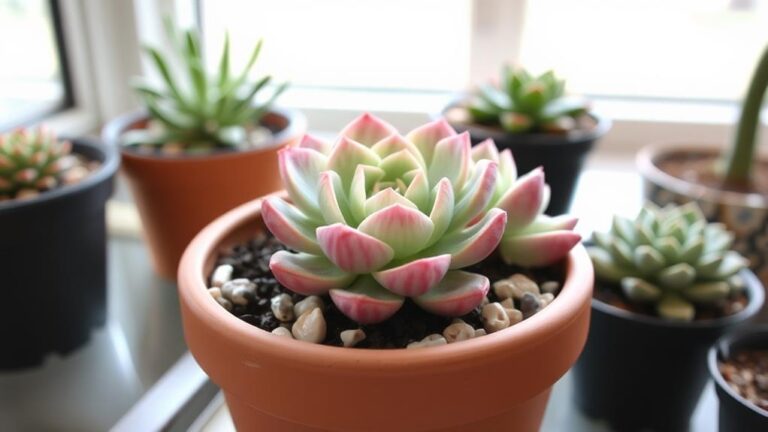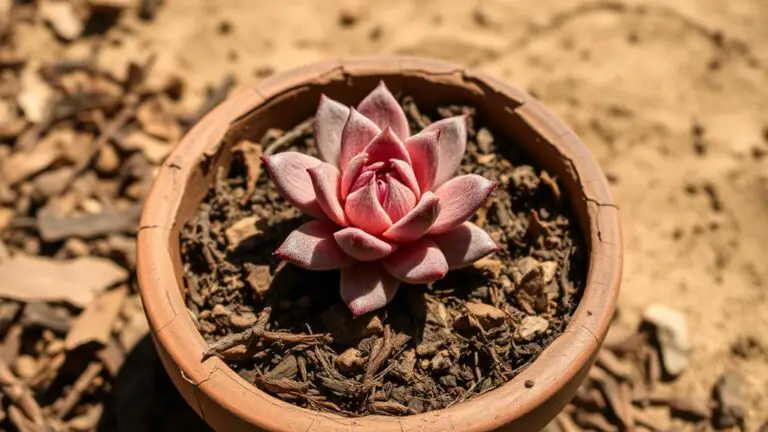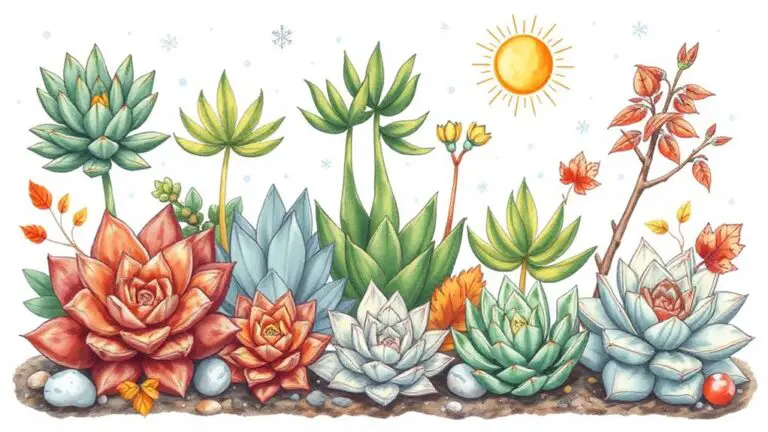5 Tips to Protect Your Succulents From Birds Eating Them
You've noticed that birds have started nibbling on your beloved succulents, and you're wondering how to keep them at bay. Implementing a few effective strategies can make a big difference in protecting your plants. For instance, using physical barriers like mesh netting is a straightforward solution, but that's just the beginning. Understanding why birds are attracted to succulents and how to distract them with bird-feeding stations can also play an essential role. Now, let's explore these tips further to guarantee your succulents stay safe and thriving.
Identify Signs of Bird Activity
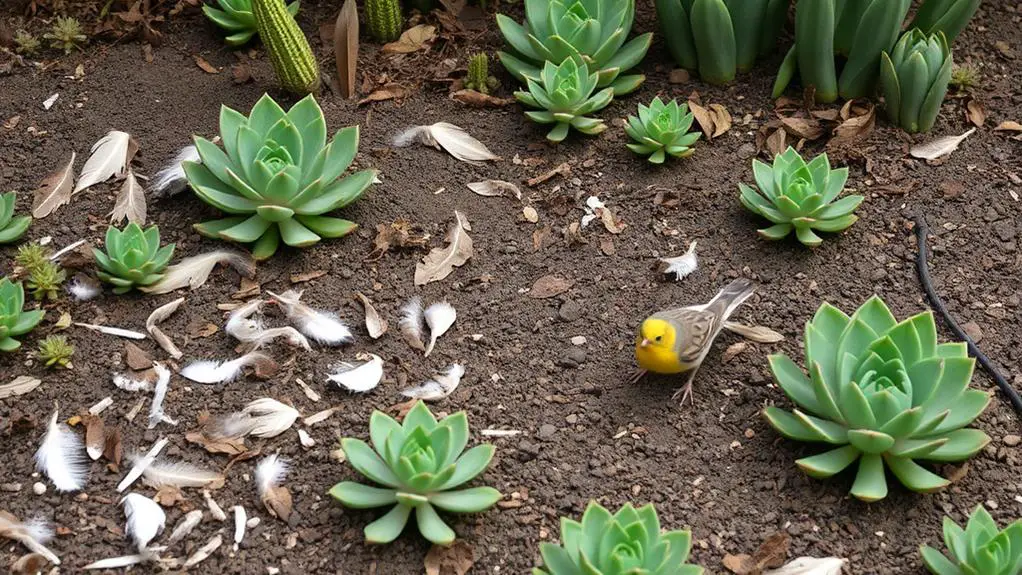
When it comes to protecting your succulents, spotting the signs of bird activity early is essential. Birds can cause significant damage to your plants, so it's important to be vigilant. Start by looking for small holes and irregular patterns in the leaves, which often indicate bird feeding activity. These marks can be subtle, so inspect your succulents closely.
Next, check for claw marks or scratches on the leaves and stems. Such signs point to birds interacting with your plants. This interaction often happens when birds land on or around your succulents, leaving behind these telltale clues.
Another thing to observe is bird droppings near the damaged plants. If you see droppings, it's a strong indicator that birds are the culprits behind the damage.
Also, keep an eye out for frequent bird activity. Birds perching or flying around your succulents can suggest they're feeding on your plants.
Understand Why Birds Eat Succulents
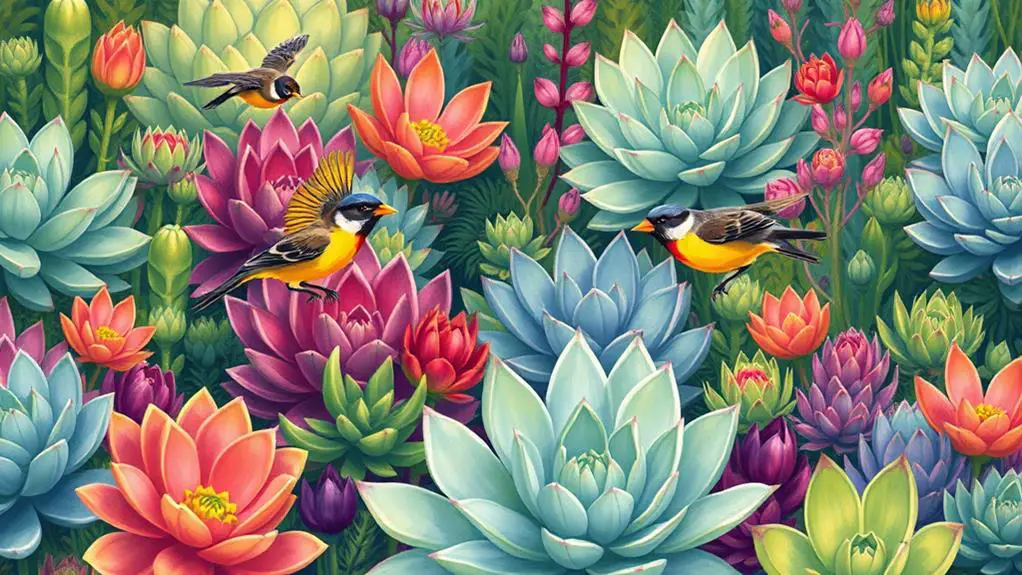
Spotting the signs of bird activity around your succulents is just the beginning. To protect your plants, you need to understand why birds are eating them in the first place.
Birds often turn to succulents for several reasons that you can address with the right strategies.
Birds are drawn to succulents primarily because of their juicy stems, which offer hydration during periods of food scarcity or drought. Additionally, some bird species eat succulents because they might contain insects, adding to their varied diet.
When birds explore their environment, they sometimes peck at succulents by accident, causing damage while searching for food. Specific birds, such as woodpeckers, target the fleshy parts of succulents for nourishment, especially when other food sources are scarce.
Understanding these motivations can help you take the right steps to protect your plants. Here are some key reasons birds might be eating your succulents:
- Hydration during droughts
- Food scarcity and limited resources
- Presence of insects in the plants
- Environmental exploration and curiosity
- Nutritional needs during certain seasons
Use Physical Barriers

Protecting your succulents from birds can be effectively achieved by using physical barriers that prevent access while still allowing essential elements like sunlight and rain to reach the plants. One great option is netting. You can install plastic or metal mesh netting over your succulents, creating a physical barrier that keeps birds out. Use garden stakes or pegs to secure the netting in place, ensuring it remains taut and effective.
Another method is using cages. Build or purchase cages with small openings around your succulents. These cages will protect the plants while allowing air and light to penetrate.
To add more protection, consider wire mesh barriers. These can be placed both underground and above-ground to deter birds from pecking at the roots and leaves, providing thorough succulent protection.
Incorporating reflective surfaces can also enhance your physical barriers. Shiny aluminum foil or reflective garden ornaments can act as bird deterrents by scaring birds away with light reflections.
Implement Deterrent Strategies

While physical barriers are a solid first line of defense, complementing them with deterrent strategies will enhance your efforts to protect succulents from birds.
Adding bird netting or wire mesh barriers works well, but combining these with other techniques can really make a difference.
Use reflective materials like pinwheels or reflective tape to create visual disturbances. These shiny objects can scare birds away.
Sound deterrents such as wind chimes or motion-activated devices that emit sounds can make birds uncomfortable and keep them away from your succulents.
Position bird feeders and baths away from your succulent garden. This will redirect bird activity, reducing their interest in your plants.
Consider placing decoys of predatory birds nearby. These can dissuade smaller birds from approaching your succulents because they'll feel threatened.
Here's a quick list to help you remember:
- Reflective materials like pinwheels or tape
- Sound deterrents such as wind chimes or motion-activated devices
- Bird feeders positioned away from succulents
- Decoys of predatory birds
- Wire mesh barriers around the plants
Set Up Bird-Feeding Stations
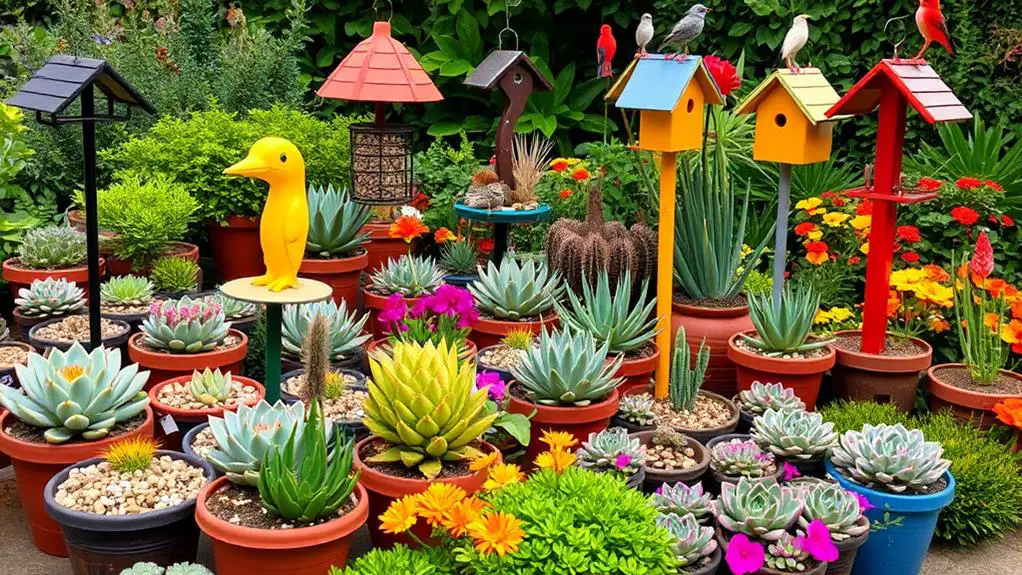
Setting up bird-feeding stations can be an effective way to divert birds' attention away from your succulents. Position your bird feeders at least 10-15 feet away from your precious plants. This distance helps keep birds away from your succulents, minimizing the risk of them venturing too close.
Choose birdseed that attracts local species but isn't appealing to birds that typically eat succulents. For instance, sunflower seeds are great for finches. Adding a water bath near the feeding station can provide the hydration birds need, which can help keep them focused on the feeder rather than your plants.
To protect your plants effectively, monitor bird activity around the feeding station. If you notice birds still targeting your succulents, you might need to adjust the location of the feeders or change the type of birdseed you're using.
Don't forget to regularly clean bird feeders and baths to prevent mold and disease. Healthy birds are less likely to forage elsewhere.
Frequently Asked Questions
How Do I Keep Birds Away From My Succulents?
Install bird netting securely with garden stakes. Use reflective tape or old CDs as visual deterrents. Set up a bird feeding station elsewhere. Employ motion-activated devices and place reflective pinwheels or mirrors around your succulents.
How Do You Keep Animals From Eating Succulents?
To keep animals from eating your succulents, install barriers like mesh netting, use reflective deterrents, and place feeders away from the plants. Regularly check for damage and consider natural repellents like cayenne pepper around the bases.
What Animal Is Eating My Succulents at Night?
Check for signs like gnawed stems, missing leaves, or animal droppings. Raccoons, rabbits, and deer often eat succulents at night. Use motion-activated cameras to identify the culprit and then install barriers or repellents to protect your plants.
What Succulents Are Safe for Birds?
You can safely plant succulents like Sedum, Echeveria, Aloe vera, and Crassula in your garden. These varieties are non-toxic to birds, ensuring a bird-friendly environment. Avoid toxic succulents like Kalanchoe and certain Euphorbia species.
Conclusion
By using these tips, you'll keep your succulents safe and healthy. Remember to set up barriers, use deterrent strategies, and place bird-feeding stations away from your plants. Keep an eye on bird activity and adjust your approach as needed. With a little effort, you'll protect your plants and enjoy watching them thrive. You've got this, and your succulents will thank you for it! Happy gardening!





